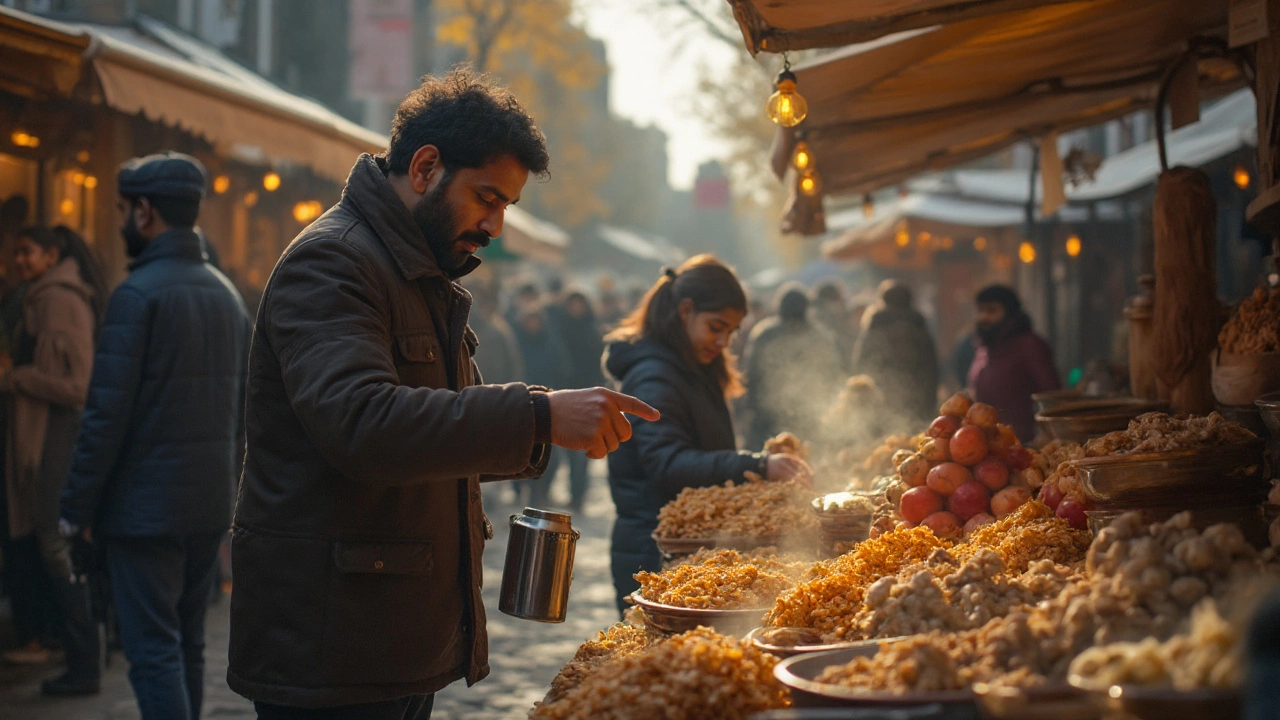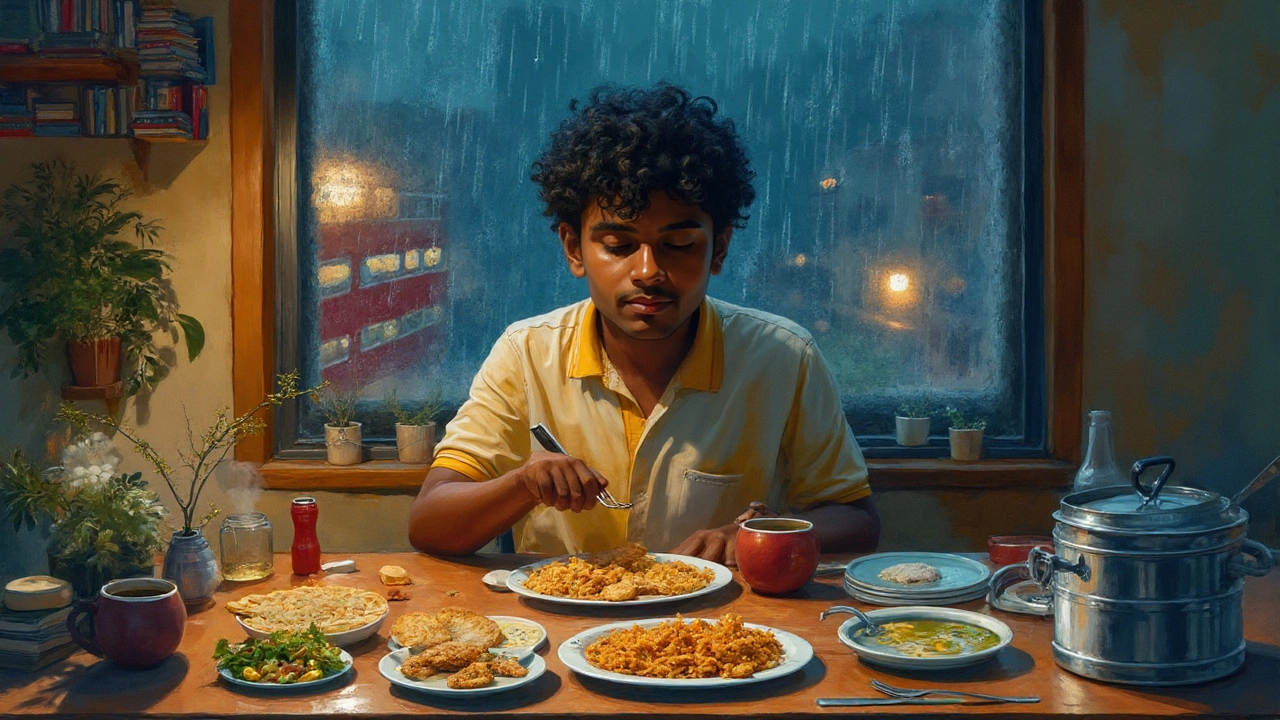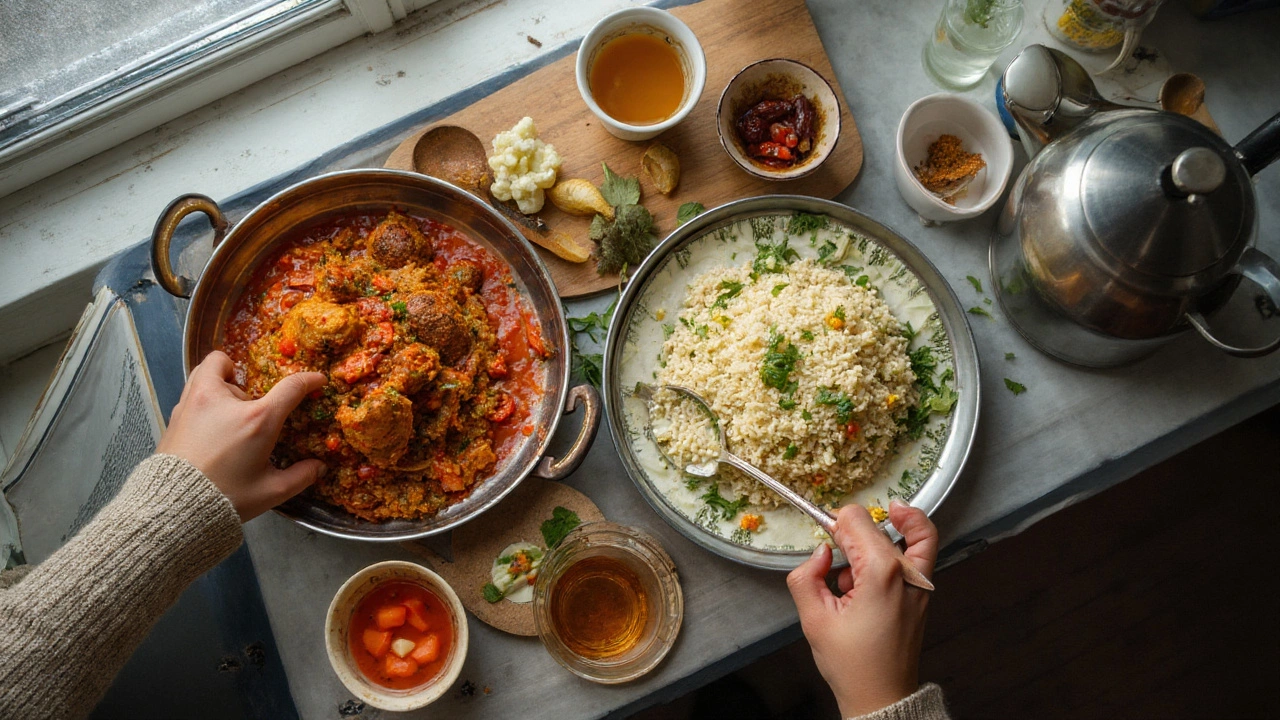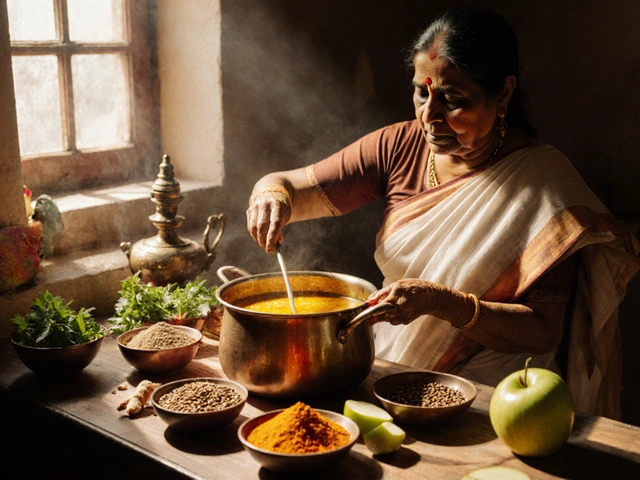TL;DR
- In Ayurveda, inflammation shows up as heat, dryness, or heaviness from disturbed Pitta, Vata, or Kapha. Food can push these levers fast.
- Usual suspects: very hot spices (chilies), sour and salty overload (vinegar, pickles), deep-fried foods, alcohol, excess sugar, old/leftover meals, heavy dairy, red meat.
- By dosha: Pitta flares with hot/sour/salty and alcohol; Vata flares with cold/raw/dry and gas-forming beans; Kapha flares with heavy/sweet/oily and dairy.
- Context matters: season, your current symptoms, how you cook, and what you pair foods with. A single tomato won’t ruin you-patterns do.
- Quick wins: cook fresh, eat warm at regular times, use gentle spices, and swap deep-fried or ultra-processed meals for simple, cooked, seasonal food.
You clicked to find out what foods are inflammatory in Ayurveda. Here’s the short answer: anything that spikes heat (Pitta), dryness and wind (Vata), or sluggishness and mucus (Kapha) can inflame. The real trick is knowing which of those is loudest in your body right now. I’ll keep it practical: clear lists, simple swaps, UK-friendly examples, and a few rules you’ll actually remember when you shop at Tesco or cook after work.
What counts as inflammatory in Ayurveda (and why it’s not the same as calories or macros)
Ayurveda doesn’t talk about “CRP levels” or “omega-6.” It talks about agni (your digestive fire), ama (sticky residue from poor digestion), and the three doshas-Vata (movement), Pitta (heat), and Kapha (structure). When food overwhelms agni or pushes a dosha out of balance, symptoms follow: acid reflux and skin flare-ups (Pitta), bloating and joint clicks (Vata), congestion and fatigue (Kapha).
Key idea from the classical texts (Charaka Samhita, Sushruta Samhita, Ashtanga Hridayam): like increases like. Too much heat leads to more heat. Too much cold and dry leads to more cold and dry. Too much heavy and oily leads to more heaviness and oiliness.
So “inflammatory foods” here means foods with qualities (gunas), tastes (rasa), and potency (virya) that stoke those patterns. Here’s what that looks like in real life.
Across all doshas, these tend to inflame when eaten often:
- Deep-fried foods and reheated oils (chips, bhajis, fried chicken). Old oil = harder to digest; the body treats it like a burden.
- Ultra-processed foods: shelf-stable biscuits, crisps, energy bars, flavoured instant noodles. They’re dry, refined, and often loaded with emulsifiers. Modern evidence also links higher ultra-processed intake with worse health markers (large cohort analyses in 2023-2024).
- Burnt/charred meats and toast. Blackened equals harsh and heating.
- Very sour and salty condiments: strong vinegar, pickles, hot sauces. A little is fine; a lot fans Pitta.
- Excess sugar and sweetened drinks. Heavy, sticky, Kapha-forming. Think milkshakes and iced coffees with syrup.
- Alcohol, especially in summer or with spicy food. Heating and drying at once.
- Old leftovers, especially meat and fish. Ayurveda prefers fresh. Leftovers tend to form ama faster.
By dosha (use this to personalise):
Pitta (prone to heat, acidity, anger, redness)
- Hot spices: chilies, cayenne, excess black pepper. Nando’s extra hot peri-peri every day? Not your friend.
- Sour and salty overload: strong vinegar, pickles, mustard, aged cheese.
- Alcohol (beer, wine, spirits), especially with spicy curries.
- Tomatoes, aubergine (eggplant), garlic, onions in excess-especially in summer or if reflux/skin is flaring.
- Fried meats and cured meats (bacon, salami).
Vata (prone to gas, dryness, anxiety, irregular appetite)
- Cold, raw, and dry foods: big salads, raw kale, rice cakes, crackers, granola.
- Gas-forming legumes: chickpeas, kidney beans, lentils-unless soaked, cooked soft, and spiced right.
- Carbonated drinks and iced drinks. Air on air.
- Excess bitter and astringent foods without enough oil: raw broccoli, Brussels sprouts, large amounts of raw cacao.
- Skipped meals and snacking on the go (yes, the food pattern itself can inflame Vata).
Kapha (prone to mucus, sluggishness, weight gain, swollen sinuses)
- Heavy dairy: cheese, full-fat yogurt (especially at night), ice cream.
- Wheat-heavy meals: large portions of bread, pastries, pizza.
- Deep-fried and creamy dishes: fish and chips, korma with cream.
- Cold and sweet foods: smoothies with banana and milk, milkshakes.
- Excess red meat and processed meats. Heavy, sticky, slow to digest.
Food combinations that stir trouble (viruddhahara): milk with fish; milk with sour fruits; fruit with heavy meals; yogurt at night; equal parts ghee and honey; heated honey; eggs with dairy. These combos are called incompatible because they confuse digestion and create more residue. Even if you feel okay after, repeat them often and you’ll likely feel the drag.
What classical sources say: The Charaka Samhita groups heating foods (ushna virya) and emphasizes moderation in pungent, sour, and salty tastes for Pitta; Sushruta warns against incompatible combinations; Ashtanga Hridayam doubles down on fresh, seasonal, and well-combined meals. Different translations phrase it differently, but the thrust is the same.
| Food/Pattern | Qualities (Ayurveda) | Likely Dosha Aggravated | Why It Can Inflame | Common UK Examples |
|---|---|---|---|---|
| Chilies, hot sauces | Hot, sharp | Pitta | Adds heat, irritates gut/skin | Peri-peri, vindaloo, sriracha |
| Deep-fried foods | Oily, heavy, often old oil | Kapha (also Pitta) | Slows digestion, creates residue | Chips, pakoras, doughnuts |
| Cold, raw salads | Cold, dry, light | Vata | Weakens digestive fire, gas | Pre-packed salad tubs |
| Alcohol | Hot, drying | Pitta, Vata | Heats tissues, disrupts sleep | Lager, wine, cocktails |
| Heavy dairy | Cold, heavy | Kapha | Promotes mucus, sluggishness | Cheddar, ice cream, lassi at night |
| Processed meats | Heavy, salty | Pitta, Kapha | Hard to digest, water retention | Bacon, salami |
| Beans (poorly cooked) | Dry, astringent | Vata | Gas and cramping | Tinned beans eaten cold |
| Vinegar & strong pickles | Sour, sharp | Pitta | Acidity, reflux | Pickled onions, chutneys |
One more nuance: fermented foods (kimchi, kombucha, kefir) can be medicinal in small, thoughtful amounts, but they’re sour and sometimes fizzy. Great for sluggish Kapha in winter mornings, risky for Pitta in July or Vata with bloating.

Spot it, swap it: a simple plan to cool, ground, or lighten your meals
Here’s a clean way to act on all this without memorising Sanskrit. Think of it as a 6-step loop you can run weekly.
- Check your current signals.
- Pitta heat signs: acid reflux, mouth ulcers, red/itchy skin, irritability, loose stools. If yes: turn down hot, sour, salty, alcohol.
- Vata wind signs: bloating, constipation, dry skin, anxiety, poor sleep. If yes: reduce raw, cold, dry, carbonated; add oil and warmth.
- Kapha sludge signs: sinus congestion, fatigue after meals, edema, weight creep. If yes: cut heavy dairy, sweets, fried foods, giant wheat portions.
- Match to the season (UK-friendly cues).
- Summer (Pitta): Go cooling. More cucumber, mint, coriander, coconut water (unsweetened), basmati rice, courgette, sweet fruits. Hold back on chilies, vinegar, tomatoes, alcohol.
- Autumn-winter (Vata): Go warm and moist. Soups, stews, porridge with ghee, root veg, soaked/cooked beans with cumin and asafoetida. Skip big cold salads and iced drinks.
- Late winter-spring (Kapha): Go light and spicy-bitter. Mustard greens, kale (cooked), rocket, turmeric, ginger, black pepper, barley, millet. Ease off dairy and sugar.
- Choose better cooking methods.
- Favour: simmering, steaming, stewing, sautéing in fresh ghee or olive oil.
- Limit: deep-frying, heavy charring, multiple reheats.
- Leftovers: If you must, aim to eat within 24 hours and reheat thoroughly. Don’t reuse old frying oil.
- Fix food pairings (the easy list to remember).
- Keep milk solo; don’t mix with fish, eggs, sour fruit, or salty foods.
- Fruit alone between meals; avoid fruit dessert after heavy mains.
- No yogurt at night; if you want it, take a small portion at lunch with cumin.
- Never heat honey. Stir into warm (not hot) drinks or drizzle on cooled food.
- Get timing and portions right.
- Eat your main meal at lunch when digestion is strongest.
- Early, light dinner-think by 8 pm if you can.
- Skip iced drinks with meals; sip warm water or ginger tea instead.
- Coffee: 1 cup in the morning with food is manageable for many; less if you’re Pitta-hot or Vata-anxious.
- Make swaps you’ll actually keep.
- Craving heat? Swap hot sauce for coriander-mint chutney with lime (cooling).
- Bacon sarnie mornings? Try spiced avocado on warm sourdough with a fried egg-skip the bacon, add herbs.
- Fish and chips Friday? Bake or air-fry fish; roast chips in the oven with turmeric and mustard seeds.
- Late-night yogurt? Warm cinnamon oat milk or golden milk (don’t boil honey; add after it cools a touch).
- Salad for lunch (Vata issues)? Turn it into a warm bowl: sautéed greens, quinoa, roasted veg, tahini-lemon dressing.
- Pitta flare and love tomatoes? Use roasted red pepper or beetroot purée for colour and body without acidity.
- Kapha slump with cheese? Swap heavy cheddar toasties for spiced hummus on warm wholegrain with rocket and radish.
Sample one-day menus by dosha (simple, UK pantry style):
Pitta-cooling day
- Breakfast: Soaked oats cooked with almond milk, chopped pear, cardamom, a few soaked raisins.
- Lunch: Basmati rice, mung dal kichari with coriander and fennel, cucumber-mint raita with coconut yogurt.
- Snack: Coconut water or peppermint tea; a slice of melon (solo).
- Dinner: Steamed courgette and asparagus with lime and olive oil, baked white fish with dill, small portion of quinoa.
Vata-grounding day
- Breakfast: Warm porridge with ghee, stewed apples, cinnamon.
- Lunch: Lamb and root veg stew with barley, side of sautéed spinach with garlic (mild).
- Snack: Warm ginger tea; a handful of soaked almonds.
- Dinner: Soft khichdi (rice + split mung), roasted carrots, a dollop of sesame chutney.
Kapha-lightening day
- Breakfast: Ginger tea, warm millet porridge with grated apple and cloves (light on sweetener).
- Lunch: Stir-fried greens with tofu or tempeh, brown rice, turmeric-ginger dressing.
- Snack: Spiced chickpeas (properly cooked) or sliced pink grapefruit.
- Dinner: Bitter leaf salad (lightly wilted), lentil soup, squeeze of lemon.
Two pro tips that save you when life gets busy in London: keep a jar of cumin-coriander-fennel tea mix (1 tsp each, steep 10 minutes) for digestion after heavier meals; batch-cook a mild dal on Sunday so a warm, easy dinner is always ten minutes away.

Cheat-sheet, quick comparisons, mini-FAQ, and next steps
Cheat-sheet: before you eat, run this mini checklist
- Temperature: Is it warm (good for most) or iced (hard on digestion)?
- Freshness: Was it cooked today? Was the oil used once?
- Heavy vs light: Will this sit like a brick? Can I digest it by bedtime?
- Taste balance: Are hot/sour/salty dominating (Pitta)? Is it too dry/bitter (Vata)? Too sweet/oily (Kapha)?
- Season match: Hot day? Cool it. Cold day? Warm it. Damp day? Spice it.
- My signals today: Acid, gas, or sludge? Adjust accordingly.
Common inflammatory triggers and better choices (UK context)
| Trigger | Why It Flares | Better Everyday Choice |
|---|---|---|
| Extra-hot curry + beer | Hot + hot + drying | Mild curry with coconut and coriander + room-temp water |
| Fish and chips (deep-fried) | Oily, heavy | Oven-baked fish + roasted potatoes with turmeric |
| Late-night yogurt | Cold, heavy, mucus-forming | Warm spiced oat milk or herbal tea |
| Big raw salad in winter | Cold, dry | Warm bowl: sautéed greens, roasted root veg, tahini |
| Cheese toastie lunch daily | Heavy dairy, Kapha-forming | Hummus, rocket, radish on warm wholegrain |
| Energy drink + crisps | Ultra-processed, dry, stimulant | Herbal tea + handful of nuts or fruit |
Mini-FAQ
Are tomatoes and aubergines always inflammatory? Not always. They’re nightshades and tend to heat and irritate in Pitta flares (acidity, skin issues). If you’re steady and it’s cool weather, small amounts, well-cooked, with cooling herbs are usually fine.
Is ghee inflammatory? In small amounts, ghee supports digestion and lubricates tissues. It’s heavy if overused or for Kapha-dominant folks. Melt a teaspoon on warm grains or veg; don’t deep-fry in it.
What about coffee? It’s heating and drying. For many, one morning cup with food is okay. If you’re anxious (Vata) or reflux-y (Pitta), reduce or switch to chicory/dandelion blends or milder teas.
Are fermented foods good or bad? Both, depending on you and the season. Sour and sometimes fizzy means great for Kapha in spring, risky for Pitta in summer, and cautious for Vata with gas. Keep portions small and observe your body’s response.
Can I eat meat? Yes, if it suits you. Meat is heavy and building. Better for Vata in winter; less for Kapha. Choose fresh, cook thoroughly with spices like ginger and black pepper, and avoid deep-frying.
Does Ayurveda ban leftovers? It discourages them. Fresh food digests cleaner. If life happens, store properly, reheat once, and don’t keep fried leftovers or seafood.
How long until I feel a change? Many people notice shifts in 3-7 days after cutting back hot/sour/salty for Pitta, cold/raw for Vata, or heavy/sweet for Kapha. Skin and weight changes take longer-think weeks, not days.
Is there modern evidence behind any of this? Different lens, similar outcomes. Large studies tie ultra-processed foods, excess alcohol, and fried foods to worse inflammatory markers and health outcomes. Ayurveda gets there through qualities and digestion rather than lab terms, but the food choices often match.
When to get medical help
If you have diagnosed inflammatory conditions (IBD, active autoimmune disease, severe eczema, uncontrolled reflux), keep your GP or specialist in the loop. Use this guide to shape meals, not to replace care. If a new food change worsens symptoms fast, stop and reassess.
Next steps by scenario
- Pitta flare (acid reflux, red skin): 2-week reset: no chilies, vinegar, tomatoes, alcohol; use coriander, fennel, mint; base meals on rice, mung dal, steamed veg. Sip coriander-fennel tea after lunch.
- Vata flare (bloating, constipation): 2-week warm plan: no iced drinks or raw salads; add 1-2 tsp ghee daily; eat stews, soups, soft grains. Use cumin, ginger, hing (asafoetida) in beans.
- Kapha flare (sinus, heaviness): 2-week light plan: cut dairy and sweets; favour bitter greens, barley, millet; add ginger, black pepper, turmeric; keep dinner very light.
- Mixed picture: Prioritise the loudest symptom. For example, if you’re gassy (Vata) and reflux-y (Pitta), first stabilise Vata with warm, simple, non-spicy meals, then cool Pitta by reducing sour/salty.
Pitfalls to avoid
- Overcorrecting: moving from spicy takeaways to cold green smoothies overnight can worsen Vata.
- Assuming “healthy” means anti-inflammatory for you: raw kale salad is not medicine for everyone.
- Ignoring timing: a perfect meal at 10 pm often lands harder than an okay meal at 1 pm.
- Chasing superfoods while keeping bad combos: heated honey or milk with fish will still trip you up.
Quick rules of thumb
- If it makes you sweat and snap, it’s probably Pitta-aggravating.
- If it makes you burp and bloat, it’s likely Vata-aggravating.
- If it makes you nap and snore, it’s probably Kapha-aggravating.
Day to day, keep it simple: warm, fresh, mostly cooked, seasonal, and spiced to suit your body. The labels and lists help, but your best guide is still how you feel an hour after you eat. That feedback loop never lies. If you only remember one phrase from this page, make it this: Ayurveda inflammatory foods are the ones that push your current symptoms-so eat to cool, ground, or lighten, depending on the day.





